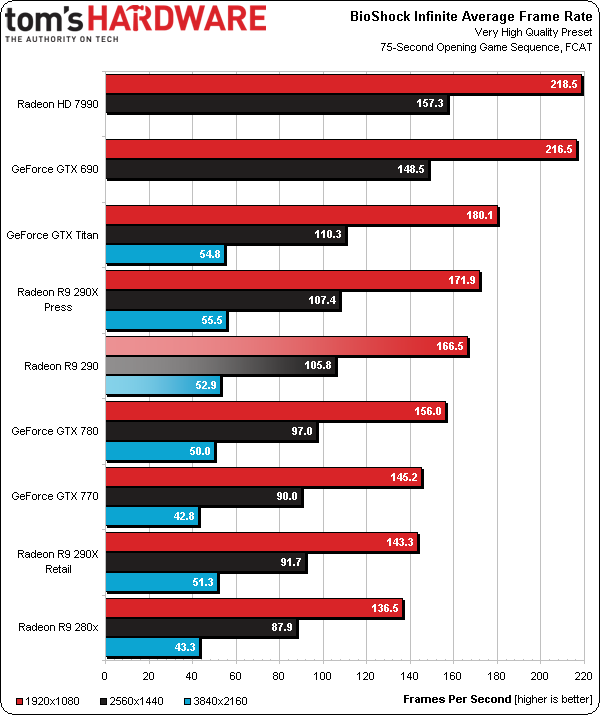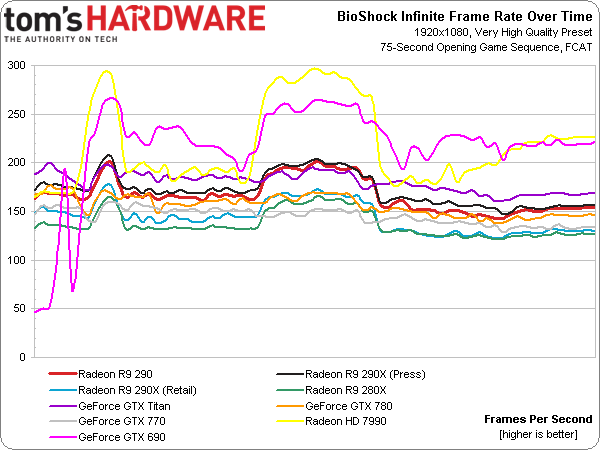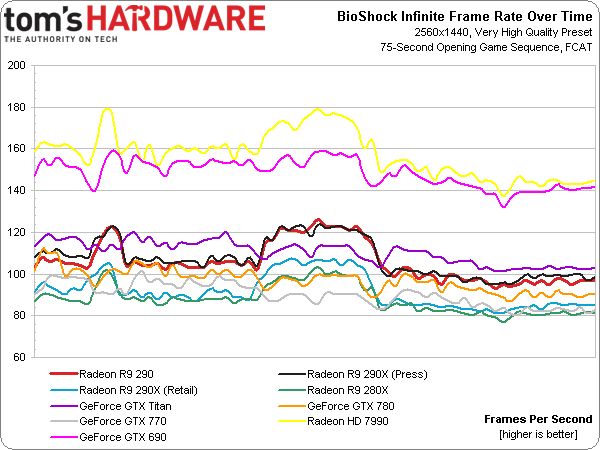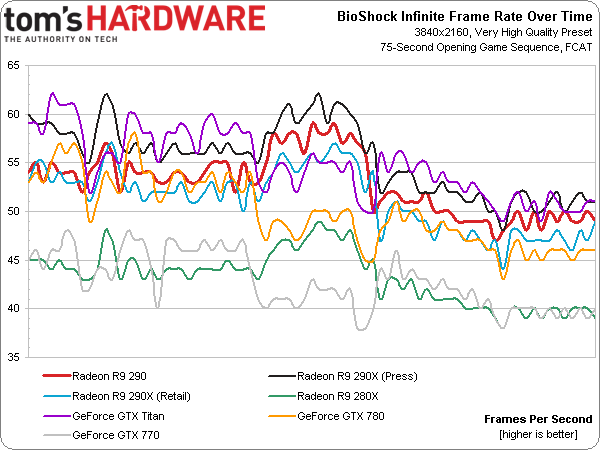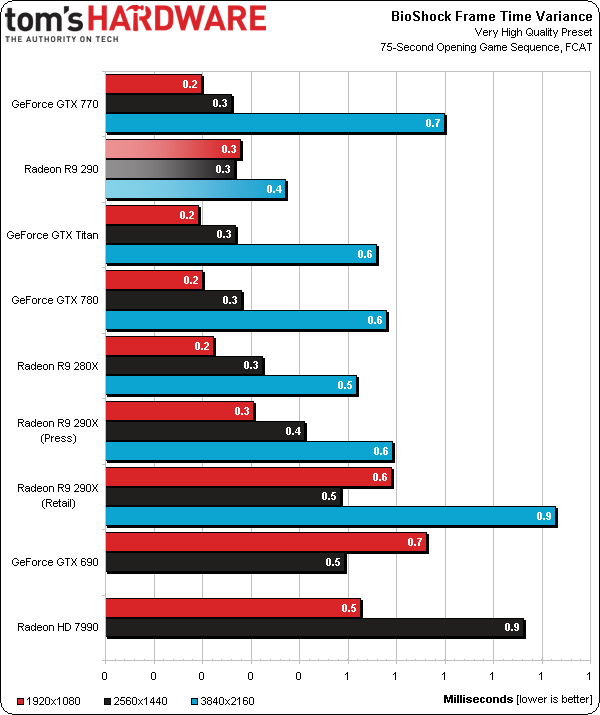AMD Radeon R9 290 Review: Fast And $400, But Is It Consistent?
We have all the makings of a dramatic launch: new high-end hardware, a last-minute delay for more performance, a crazy twist based on retail hardware, and our own home-baked solution to AMD's noise problem. Does Radeon R9 290 impress us or fall short?
Results: BioShock Infinite
The BioShock numbers line up pretty well at FHD and QHD resolutions, too. Radeon R9 290 shows up just behind our 290X press board, which is to say that both are faster than GeForce GTX 780.
Notice that GeForce GTX Titan shows up in front of the Radeon R9 290X. On this page, it actually trailed by quite a bit. The difference, of course, is in the five-minute pre-test heat-up that each card is subjected to in today’s review. Once we shed the overly-ambitious frequency that you’d never enjoy while playing BioShock, the finishing order shifts. Our press card is still a great performer—its result is merely tempered.
This procedure isn’t at all friendly to the retail card, though. At 1920x1080, it shows up behind GeForce GTX 770. At 2560x1440, it manages a slight win over the GK104-based board. But it still trails GeForce GTX 780. Only at 3840x2160 does our retail 290X leapfrog the 780.
It’s safe to say that the AMD-supplied 290X and 290 cards, along with the retail 290X, are all playable at Ultra HD resolutions. We’re still wary of the big gap between both of our Radeon R9 290X cards, though.
Frame time variance in BioShock is exceedingly low. Even in a worst-case scenario, the latency between successive frames should appear minimal.
Get Tom's Hardware's best news and in-depth reviews, straight to your inbox.
Current page: Results: BioShock Infinite
Prev Page Results: Battlefield 4 Next Page Results: Crysis 3-
slomo4sho This is a win at $400! Good job AMD!Reply
http://techreport.com/review/25602/amd-radeon-r9-290-graphics-card-reviewed/9
11865199 said:However, the two retail Radeon R9 290X boards in our lab are both slower than the 290 tested today. They average lower clock rates over time, pushing frame rates down. Clearly there’s something wrong when the derivative card straight from AMD ends up on top of the just-purchased flagships. So who’s to say that retail 290s won’t follow suit, and when we start buying those cards, they prove to underperform GeForce GTX 780? We can only speculate at this point, though anecdotal evidence gleaned from our experience with R9 290X is suggestive.
Chris, these results differ drastically from real world results from 290X owners at OCN... I understand that your observations are anecdotal and based on a very small sample size but do you mind looking into this matter further because putting such a statement in bold in the conclusion even though it contradicts real world experiences of owners just provides a false assumption to the uninformed reader...
The above claim has already escalated further than it should... A Swiss site actually has already rebutted by testing their own press sample with a retail model and concluded the following:
With the results in hand, the picture is clear. The performance is basically identical between the press copy and graphics card from the shelf, at least in Uber mode. Any single frame per second is different, which is what may be considered normal as bonds or uncertainty in the measurements.
In the quiet mode, where the dynamic frequencies to work overtime, the situation becomes slightly turbid. A minor performance difference can be seen in some titles, and even if it is not about considerable variations, the trend is clear. In the end, it does an average variance tion of only a few percent, ie no extreme levels. The reason may include slightly less contact with the cooler, or simply easy changing ambient temperature. -
Heironious This is weird, something must be wrong with your system. I have an i5-2500, GTX 780, 16 GB G Skill 1333, 500 GB samsung SSD, Windows 8.1 64 bit, and on Ultra with 4x MSAA I get 80 - 100 FPS....Reply -
Heironious Multiplayer would add more stress to the CPUs / GPU's. Like I said, something is wrong with their machine. I would prob get higher on single player. Im going to check and find out.Reply -
slomo4sho Reply11865222 said:According to Tom's Benchmarks Nvidia's price drop just became meaningless
Now to wait for the non-reference cards at the end of the month! -
jimmysmitty I agree that the stock cooling is pretty bad but in honesty, no matter how nice they make it after market is always better. The Titan may not have had after market but if it did it would have cooled better.Reply
It looks like a good card for the price as it even keeps up with the $100 more GTX780. This is good as NVidia may drop prices even more which means we could also see a price drop on the 290X and I wouldn't mind a new 290X Toxic for sub $500. -
guvnaguy In terms of potential performance it seems like a great card, but you get what you pay for with regards to chip quality and cooling.Reply
Best to wait a month or two before buying to see how this all goes down
